|
The pattern on side a
with 140 days in a central position flanked by twice 45 days is more
easy to remember than the first 'objective' description with twice
44 days surrounding a central period with 142 days:
|
44 |
 |
37 |
 |
102 |
 |
44 |
|
Ga2-14 (45) |
Ga3-23 (83) |
Ga7-16
(186) |
|
45 |
140 |
45 |
|
44 |
 |
37 |
 |
102 |
 |
44 |
|
Ga2-14 (45) |
Ga3-23 (83) |
Ga7-16
(186) |
|
230 |
The greater symmetry
makes it more easy to recollect, and the criterion of
'objectivity' should rely on symmetry rather than on simple
undigested facts.
Symmetry depends on
perception. To perceive is to 'digest'
inputs, and it is a slow process which requires repeated 'thinking'.
What is perceived changes with time.
The tails of the
mago in Ga3-23 and Ga7-16 are drawn alike, while the tail in
Ga2-14 on closer inspection is revealed to be different.
 |
102 |
 |
|
Ga3-23 (83) |
Ga7-16
(186) |
|
104
= 4 * 26 |
It explains
why Ga3-23 is assymmetrically located, and not in the middle of the 140 day long
period, because Ga3-23 is required to be where it is in order to
define
4 'quarters' of 26 days.
4 * 26 = 8 *
13, and the perfect number 8 can here be perceived as connected
with 13
day periods. On the other hand it is also connected with
fortnights, because 8 *
14 = 112 (= 140 - 28). Sun has 8 periods with 13 days (104) and moon has 10 periods with 14 days
(140). Sun is
connected with the perfect 8 and moon with number 10 (which
implies the cycle of life and death). 104 has 0 in the center,
140 at the end.
230 - 104 = 126 = 7 * 18, a combination of the basic moon count
period (7 nights in a week) with a possible basic sun count period (18,
a tenth of 180). 7 * 20 = 140 and 18 * 20 = 360.
|
|
Perception is a
complex process which we cannot take for granted, as the
following example will show.
I quote from the book
"Dendroglyphs of the Chatham Islands" by Christina Jefferson. The
Moriori fishermen, now probably extinct as a people, were living on
these islands before the Maori came, and they had a custom of
carving human figures in the bark of living trees, drawings which
Jefferson tried to save to the afterworld by carefully copying as
much as possible. |
|
"Some light was perhaps shed,
one afternoon in Mrs. Martin's cottage, on the second group of human
figures, those said by the islanders to represent definite
individuals. After we had enjoyed a cup of tea, the old lady was
shown a collection of sixty of these drawings. No remarks were made
by me, no questions were asked by either of us and no suggestions
were made.
She gave polite attention to
them and remained remotely indifferent until we came to the one
numbered 20, when her attitude changed and she showed interest and
animation.
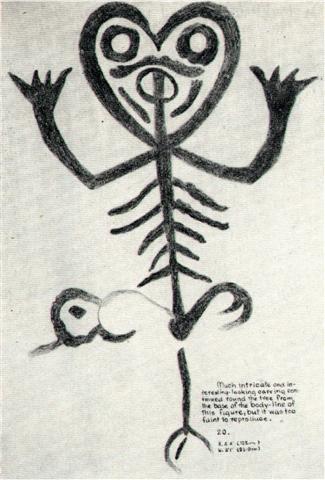
Treating this one and those that
followed as if they represented persons known to her, she viewed
them with much deference making precise remarks. At 20 she said, 'An
important person,' at 21 with added emphasis, 'A very important
person,' at 22, 'A lady,' at 23, 'Yes! I think that is a lady.
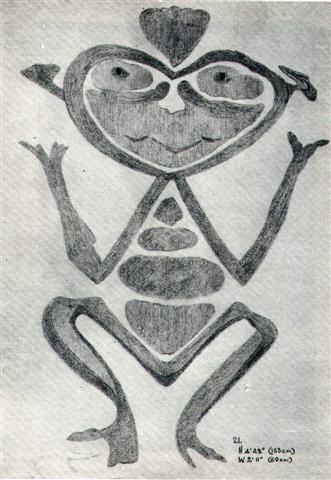 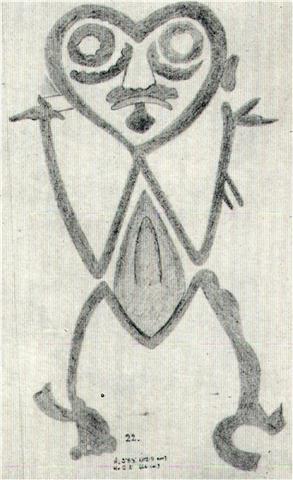 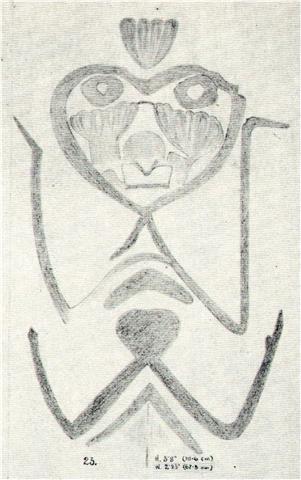
Number 24 did not please her
very much and she just nodded slightly. At 25 she smiled:
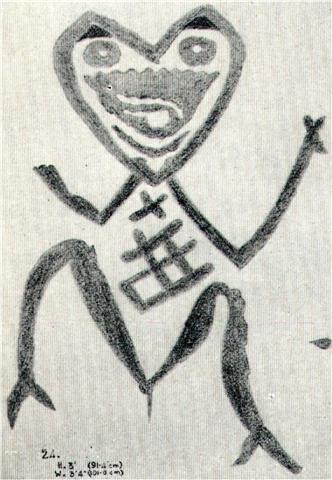 
These were people she seemed to
know. She held up the drawings as we would do photographs, turning
them this way and that to let the light fall on them from different
angles.
At 26 she was indulgent and
remarked, 'A pretty little thing,' at 27 she was somewhat rueful and
shrugged lightly as much as to say, 'There are people like him in
this world';
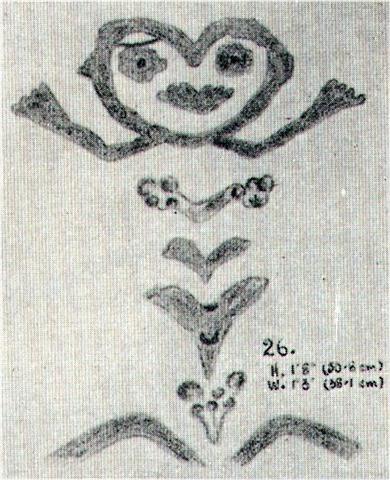 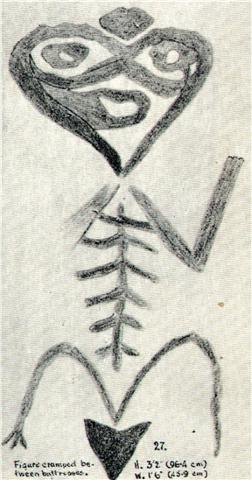
at 28 she was very pleased,
seeming to regard the figures with affection and satisfaction as she
said, 'Husband and wife.'
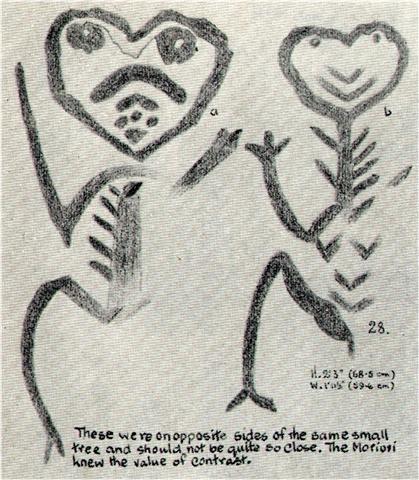
She considered 29, holding her
head now on one side and then on the other, saying appreciatively
and with real tenderness in her tones, A nice face, a very nice
face."
 |
The number of
glyphs on the G tablet is 471, but the text seems to be longer. Can we
perceive this?
If we count
glyphs we do not have to stop at 471, we can continue, and if the glyphs
give support for higher numbers, than we can in a way perceive it.
Twice 180 = 360
and twice 140 = 280. If we add them we get 640, a numinous maximum.
8
and multiples of 8 (and especially 64) should be signs for us. 360 - 104 =
256 = 4 * 64 = 8 * 32.
280 - 104 = 176 = 8 * 22.
Beginning to
count from Gb8-30 we will reach 360 at Gb5-6 (where 5 * 6 = 30, or maybe 5 *
60 = 300):
 |
296 |
 |
 |
 |
|
Ga3-1 (61) |
Gb5-4 |
Gb5-5 |
Gb5-6 (360) |
|
300 |
Does it mean we
should think 300 + 280 = 580? No, it is equally reasonable to say that sun
does not arrive to the island until two months have passed from new year.
Sun will then be shining on the island for 10 months.
Beyond Gb5-6
there are 4 * 28 = 112 glyphs up to and including Gb8-30. Another 28 glyphs
will bring us to Ga1-28:
 |
|
 |
|
 |
 |
|
Gb5-6 (360) |
Gb8-30 (472) |
Ga1-28 (500) |
Ga1-29 |
|
140 = 5 * 28 |
28 is important. Mago
at Ga7-16 could be connected with 28
because 7 * 16 = 112 = 4 * 28.
Also mago at
Ga2-14, where 2 * 14 = 28.
And the distance between
them is 5 * 28:
|
44 |
 |
37 |
 |
102 |
 |
44 |
|
Ga2-14 (45) |
Ga3-23 (83) |
Ga7-16
(186) |
|
45 |
140
= 5 * 28 |
45 |
140 resembles 150 in being half a full
cycle (of 280 respectively of 300). If
we regard Ga1-29 as outside the regular
calendar, we should continue from Ga1-30
and count to 140:
 |
|
 |
|
 |
|
Ga1-30 (1) |
Ga7-1 (141) |
Ga8-26 (200) |
|
30 |
 |
 |
 |
 |
|
Ga7-1 |
Ga7-2 |
Ga7-3 |
Ga7-4 |
Viri is a sign which can
be considered a kind of confirmation that we are on the right track. But a
viri should be connected with 29, and neither 141 nor 171 (as counted from
Gb8-30) are multiples of 29.
6 * 29 = 174, though. And the
number of glyphs in line a6 is 29. Moreover, 140 is the sum of the number of
glyphs in lines a1-a5:
|
a1 |
30 |
30 |
b1 |
26 |
26 |
|
a2 |
29 |
59 |
b2 |
35 |
61 |
|
a3 |
24 |
83 |
b3 |
30 |
91 |
|
a4 |
27 |
110 |
b4 |
33 |
124 |
|
a5 |
30 |
140 |
b5 |
29 |
153 |
|
a6 |
29 |
169 |
b6 |
28 |
181 |
|
a7 |
34 |
203 |
b7 |
31 |
212 |
|
a8 |
26 |
229 |
b8 |
30 |
242 |
|
sum |
229 |
sum |
242 |














